Red light therapy speeds up your wound recovery in seven powerful ways. It boosts your cells' energy production through enhanced mitochondrial function, letting them work harder to repair damage. You'll experience less pain and inflammation as the therapy modulates your immune response and increases blood flow. It stimulates natural collagen growth while promoting new blood vessel formation, essential for tissue repair. The therapy minimizes scarring through proper collagen alignment and helps regulate the healing process. It supports faster post-surgery recovery by reducing swelling and pain. For ideal healing, you'll want to understand how each of these mechanisms works together.
Boosting Cellular Energy Production
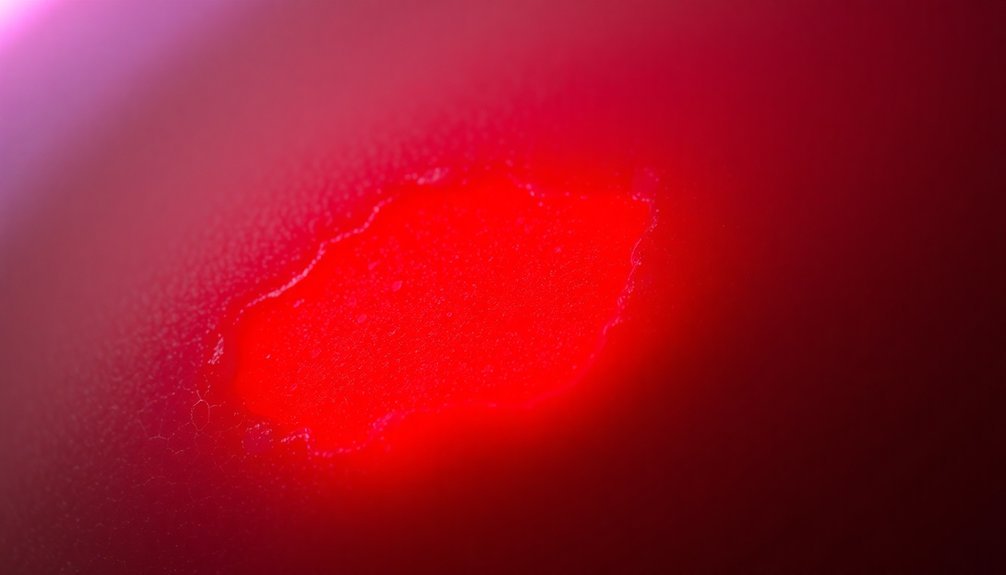
The remarkable power of red light therapy lies in its ability to supercharge your body's cellular energy production. When red light penetrates your tissue, it stimulates your mitochondria – the powerhouses of your cells – to produce more ATP, the essential energy molecule your body needs for healing.
You'll benefit from enhanced cellular function as red light interacts with cytochrome c oxidase, a key enzyme in your cells' energy production process. This interaction breaks up harmful nitric oxide bonds that can block energy production, allowing your cells to work more efficiently. The therapy helps cells use oxygen more efficiently, promoting faster healing through enhanced energy production.
The therapy excites electrons in your cellular machinery, improving the movement of hydrogen ions vital for ATP synthesis.
Red light therapy doesn't just boost energy production – it also increases the actual number of mitochondria in your cells. This means you'll have more cellular engines working to power your healing process.
As the therapy applies mild beneficial stress to your cells, they become more resilient and better at managing energy production. Through these mechanisms, you're providing your cells the tools they need to accelerate wound healing and tissue repair.
Fighting Inflammation and Pain
Your body's response to red light therapy includes fast pain relief through its natural anti-inflammatory mechanisms, which target both acute and chronic inflammation.
You'll notice reduced swelling and discomfort as the therapy increases blood flow and decreases inflammatory markers in the treated areas.
The therapy speeds up nerve recovery while providing targeted pain relief, making it particularly effective for conditions like arthritis and wound-related pain. The process works by stimulating cellular ATP production in your body's mitochondria, boosting healing energy at the cellular level.
Immediate Pain Relief Benefits
Pain relief arrives swiftly when red light therapy targets inflamed tissues, working through multiple pathways to reduce discomfort.
You'll notice the effects as increased blood flow rushes to damaged areas, helping remove toxins and waste products that contribute to pain. The therapy's ability to decrease oxidative stress and boost antioxidant production directly tackles inflammation at its source. The treatment stimulates ATP production in cells to enhance natural healing processes.
When you undergo red light therapy, you're benefiting from its proven impact on various pain conditions. Clinical trials show significant improvements in knee osteoarthritis, fibromyalgia, and athletic recovery.
You'll experience less muscle soreness and improved joint function as the therapy relaxes your muscles and enhances circulation.
The treatment's effects go beyond surface-level relief, influencing your nerve cells and neural pathways. You'll find relief from neuropathic pain as the therapy releases neuroprotective substances and modulates inflammation.
Whether you're dealing with post-surgical discomfort, migraines, or chronic pain conditions, red light therapy offers a thorough approach to pain management. The therapy's ability to accelerate tissue repair while simultaneously reducing inflammation makes it particularly effective for immediate pain relief.
Natural Anti-inflammatory Response
Building upon the immediate pain relief benefits, red light therapy triggers a powerful natural anti-inflammatory response in your body. When the red light penetrates your tissue, it stimulates the production of natural anti-inflammatory compounds, particularly polyphenols and flavonoids, which help regulate your body's inflammatory pathways.
The therapy works by activating multiple healing mechanisms simultaneously. Natural products like these have been used for healing since ancient civilizations, with records dating back to 2600 BC in Mesopotamia. It helps inhibit NF-κB, a key protein complex that controls inflammation, while promoting the down-regulation of inflammatory cytokines like TNF-α and IL-1β. You'll benefit from increased production of anti-inflammatory cytokines such as IL-10, which helps control and balance your inflammatory response.
What's particularly impressive is how red light therapy modulates reactive oxygen species (ROS) levels in your wound area. It activates antioxidant enzymes that neutralize harmful free radicals, preventing excessive oxidative stress that can delay healing.
This process supports all four phases of wound healing – from hemostasis through remodeling – ensuring your tissue repairs efficiently. The therapy's ability to regulate inflammation is vital because while some inflammation is necessary for healing, excessive inflammation can impair recovery and lead to chronic wounds.
Nerve Recovery Acceleration
Three key mechanisms make red light therapy especially effective for nerve recovery and pain management. First, it stimulates cellular repair by promoting the growth of new nerve tissues, which is essential for restoring sensation and movement. Second, it enhances blood vessel dilation, ensuring ideal blood flow to damaged areas. Third, it boosts ATP production, accelerating your body's natural healing processes. These benefits are particularly valuable for treating peripheral neuropathy symptoms, which commonly affect the hands and feet with tingling and numbness.
When you undergo red light therapy, you'll experience both immediate and long-term benefits for nerve recovery:
| Immediate Effects | Long-term Benefits |
|---|---|
| Pain reduction | Enhanced nerve regeneration |
| Decreased inflammation | Improved sensation |
| Better blood flow | Restored mobility |
| Reduced tingling | Sustained healing |
The therapy's effectiveness lies in its ability to penetrate deep into your tissues, where it reduces oxidative stress and promotes the production of healing anti-inflammatories. You'll notice a significant decrease in pain levels after regular sessions, as the treatment works to enhance your cellular function and support your body's natural inflammatory response. This thorough approach helps speed up recovery while addressing both the symptoms and underlying causes of nerve damage.
Stimulating Natural Collagen Growth
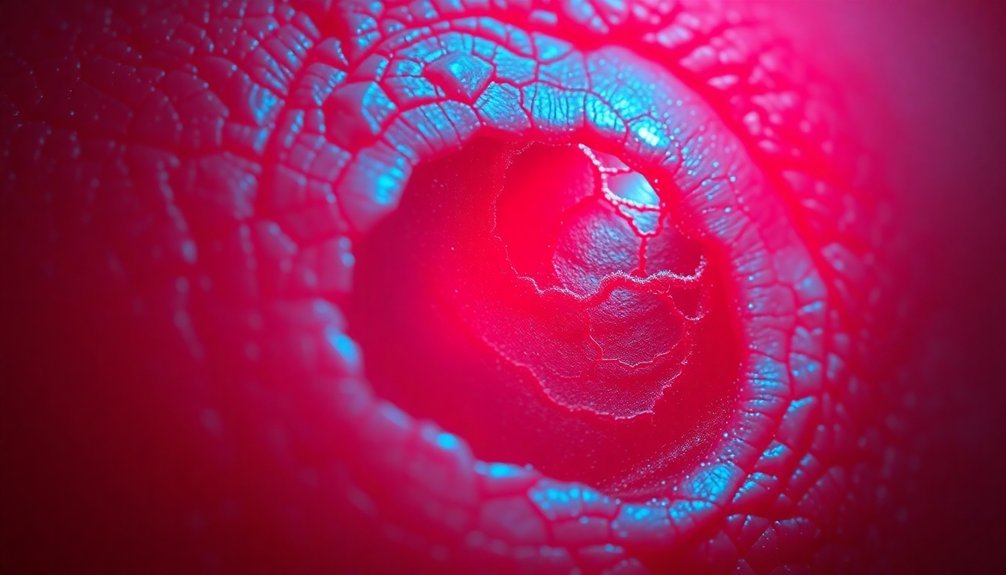
Nature's remarkable healing process gets a powerful boost through red therapy's ability to stimulate natural collagen growth. When red and near-infrared light penetrates your skin, it activates fibroblasts, the specialized cells responsible for producing collagen. This activation triggers increased collagen synthesis and deposition, essential components for proper wound healing.
You'll benefit from red therapy's ability to enhance extracellular matrix production while promoting granulation tissue formation. The treatment works by upregulating vital growth factors like VEGF and FGF, which support your body's natural healing mechanisms. Regular treatments lasting 10-20 minutes are typically sufficient to achieve optimal healing benefits.
It's particularly effective at modulating inflammatory responses, preventing the chronic inflammation that can delay recovery.
Clinical evidence supports these benefits, showing that you'll experience faster healing across various wound types, from surgical incisions to chronic ulcers. The therapy's photobiomodulation effect reduces oxidative stress while promoting beneficial ROS and NO signaling in your tissues.
You'll notice accelerated wound closure, improved skin appearance, and reduced pain during recovery.
What makes this treatment particularly appealing is that it's non-invasive and drug-free, offering you a natural way to enhance your body's collagen production and speed up the healing process.
Enhancing Blood Vessel Formation
Blood vessels serve as essential highways for healing, and red light therapy excels at promoting their formation through a process called angiogenesis. When you undergo red light therapy at 650 nm wavelength, it activates your endothelial cells, which are vital for creating new blood vessels.
This activation triggers an increase in calcium influx and nitric oxide production, setting the stage for enhanced blood vessel growth. The therapy helps overcome age-related vascular challenges by restoring arterial elasticity.
The therapy's effectiveness comes from its ability to boost vascular endothelial growth factor (VEGF) production, especially in low-oxygen conditions. You'll benefit from increased cell proliferation as the therapy stimulates your cellular processes and bioenergetics.
This combination of VEGF production and cell growth leads to faster wound healing and improved tissue repair.
You'll find that red light therapy outperforms near-infrared light (808 nm) in promoting blood vessel formation. It's a safe, non-invasive option that you can use on various wound types, from burns to surgical incisions.
The increased blood vessel formation means better oxygen delivery to your wound site, which accelerates healing and strengthens the repaired tissue. Whether you're dealing with an open wound or a sutured incision, red light therapy can help optimize your recovery process.
Minimizing Scar Development
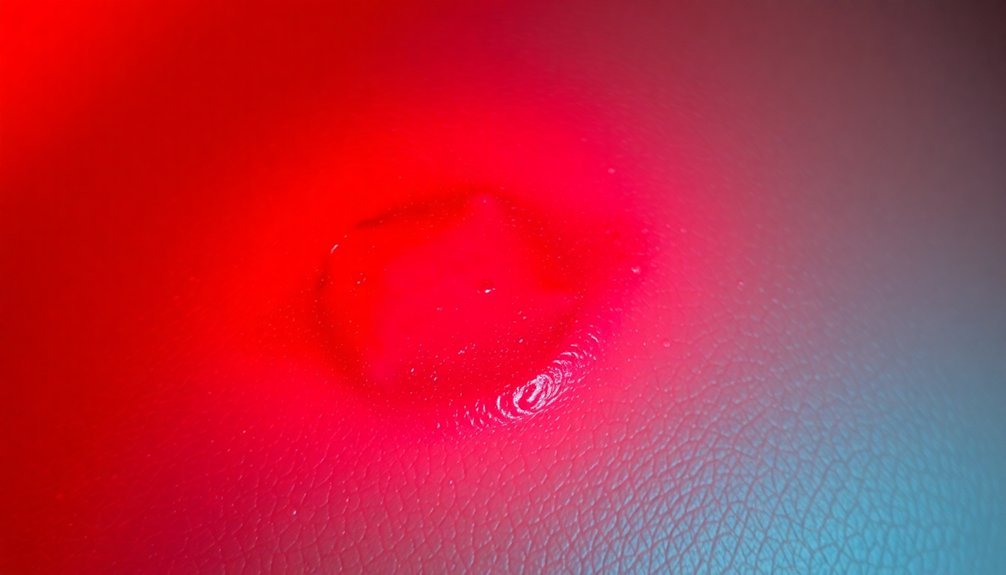
Scar formation poses a substantial challenge in wound healing, but red light therapy offers a powerful solution for minimizing its development. When you receive red light treatment, it stimulates your cells to produce more ATP, enhancing the healing process while reducing the formation of excess scar tissue. The therapy helps regulate the inflammation and proliferation phases that characterize normal wound healing.
| Benefit | Mechanism | Outcome |
|---|---|---|
| Reduced Inflammation | Decreases inflammatory response | Less fibrotic tissue formation |
| Collagen Enhancement | Promotes proper collagen alignment | Improved scar appearance |
| Enhanced Blood Flow | Stimulates new vessel formation | Better tissue oxygenation |
| Cellular Regeneration | Increases growth factor production | Healthier tissue repair |
You'll find that early application of red light therapy post-injury or surgery can markedly prevent hypertrophic and keloid scarring. The therapy works by controlling fibrosis while promoting healthy tissue growth, making it particularly effective for preventing excessive scar formation. What's more, you can safely combine this non-invasive treatment with other scar management approaches for best results. The therapy's ability to modulate skin fibrosis and improve scar pliability makes it an invaluable tool in wound recovery, especially when used at higher fluences during the early stages of healing.
Supporting Post-Surgery Recovery
Red light therapy's remarkable effectiveness in post-surgical recovery has transformed how patients approach their healing journey. You'll experience reduced inflammation and swelling as the therapy stimulates blood flow to your surgical site, naturally decreasing post-operative pain while minimizing your need for opioid medications.
The therapy works deep within your tissues, where near-infrared light penetrates to accelerate healing at the cellular level. You'll notice improved collagen production, which strengthens wound closure and enhances tissue regeneration.
This process not only speeds up your recovery but also reduces the risk of complications and infections.
As you progress through recovery, you'll find it easier to regain mobility and flexibility. The therapy helps release tissue tension and supports your physical therapy efforts, allowing you to return to normal activities sooner. It's particularly effective when started early in your recovery process.
Beyond physical benefits, you'll appreciate the therapy's positive impact on your mental well-being. It's a non-invasive, stress-reducing treatment that supports both your physical and emotional recovery, making it an invaluable tool in your post-surgical healing journey.
Strengthening Tissue Regeneration
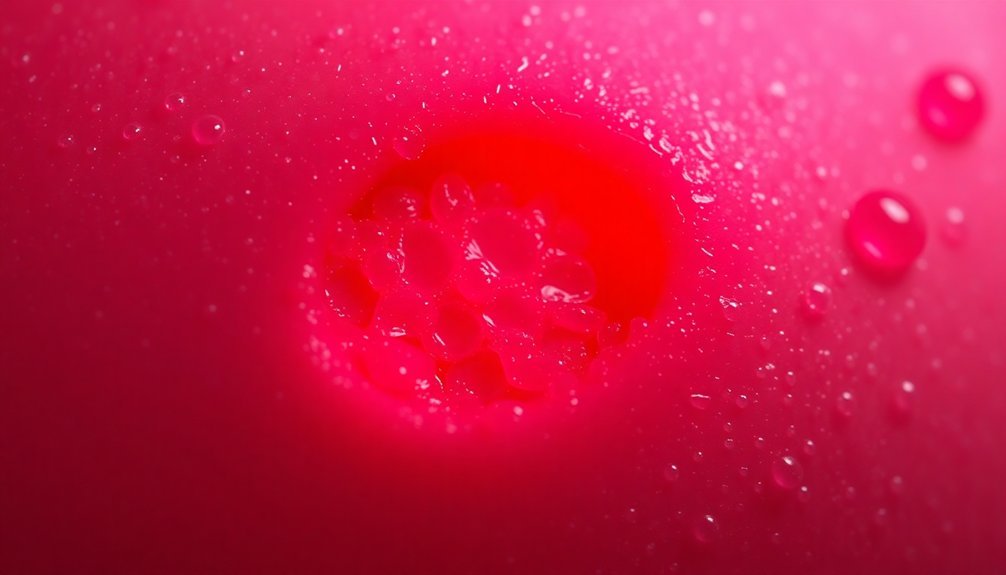
Building on the healing power of post-surgical care, tissue regeneration represents a key mechanism in your body's recovery process. When you undergo red light therapy, it activates multiple pathways that strengthen your body's natural regenerative abilities, helping you heal faster and more effectively.
- Your cells' energy production gets a significant boost through enhanced mitochondrial function, increasing ATP levels that power tissue repair and cellular regeneration.
- You'll experience increased collagen production as the therapy stimulates your fibroblasts, leading to stronger tissue formation and reduced scarring during the healing process.
- Your blood circulation improves through increased nitric oxide production, delivering essential oxygen and nutrients to damaged areas while removing waste products that can slow healing.
- You'll benefit from accelerated cell regeneration as red light therapy promotes the formation of new skin cells and granulation tissue, essential components for proper wound closure and infection prevention.
These regenerative processes work together to speed up your recovery, reduce inflammation, and promote healthier tissue formation.
The therapy's ability to enhance your body's natural healing mechanisms makes it particularly effective for wound recovery and tissue repair.
Frequently Asked Questions
How Long Should Each Red Light Therapy Session Last for Optimal Results?
You'll want to start with 5-10 minute sessions and gradually increase to 15-20 minutes. Don't exceed 30 minutes per session. For best results, maintain a consistent schedule of 3-5 sessions weekly.
Can Red Light Therapy Be Harmful if Used on Open Wounds?
Yes, red light therapy can be harmful if you don't use it properly on open wounds. You'll need protective eyewear, proper device settings, and a doctor's guidance to avoid burns, infections, or complications.
What's the Recommended Distance Between the Device and Treatment Area?
You'll want to position your device 12-24 inches away for general treatment. For deeper tissue therapy or wounds, you can move closer to 6-12 inches, but always monitor your comfort and skin's response.
Is Red Light Therapy Covered by Health Insurance for Wound Recovery?
Your insurance may cover red light therapy for wound recovery if it's prescribed by a physician and deemed medically necessary. Coverage varies by provider, so you'll need detailed documentation to support your claim.
Can Red Light Therapy Help With Diabetic Wounds and Ulcers?
Yes, red light therapy can help heal your diabetic wounds and ulcers. It'll boost your cellular energy, improve blood circulation, reduce inflammation, and speed up wound closure while stimulating collagen production and tissue regeneration.
In Summary
You'll see remarkable benefits when you incorporate red light therapy into your wound healing routine. By boosting your cells' energy production, reducing inflammation, and promoting collagen growth, you're giving your body powerful tools for recovery. Whether you're healing from surgery or treating minor injuries, this natural approach will speed up your healing process while minimizing scarring. Take advantage of red light therapy to support your body's remarkable ability to heal.

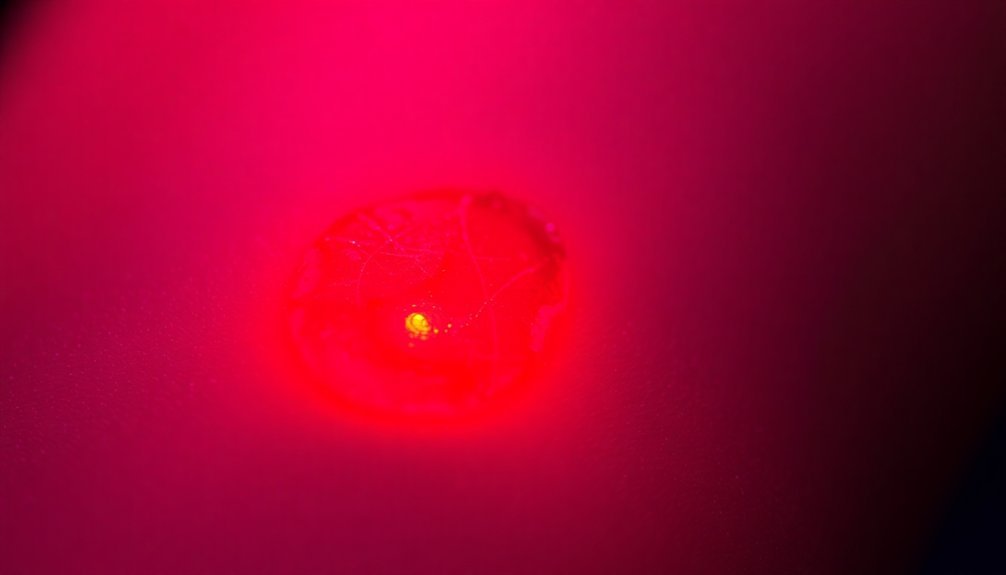



Leave a Reply